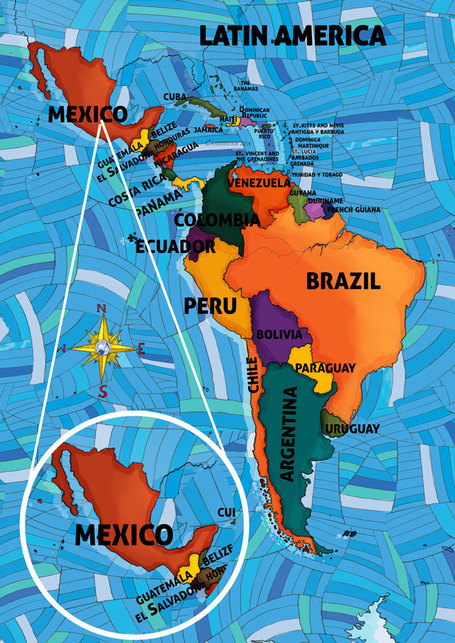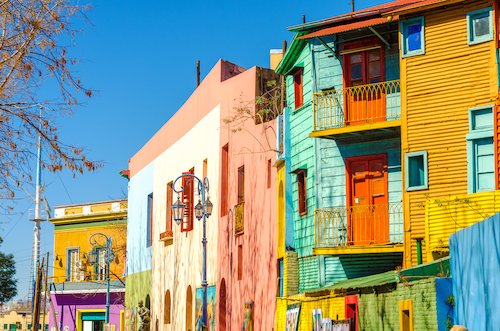|
Latin America is a region of the Americas. People do not completely agree which countries are in Latin America, but normally, it is the parts where Spanish and Portuguese are spoken (South America, Central America, and Mexico). Sometimes the Caribbean Islands are also included. Other people call all American countries where people speak Spanish, Portuguese, and French Latin America.
(retrieved from https://wiki.kidzsearch.com/wiki/Latin_America) |
Brazil
|
|
|
|
The music of Brazil has influenced African, European, and Amerindian forms of music. Brazilian music has also developed its own unique style such as samba, pagoda, and bossa nova!
Brazil Fun Facts
|
Brazilian Instruments
Samba
|
The Samba dance Brazil style is a tradition, a custom, the heart and soul of the music and dance throughout the country. It's a Brazilian dance with roots going as far back as the 19th century.
The popular Carnival celebration in Rio de Janeiro is known for the dancing of the Samba through the streets. It's a very quick dance with a lot of fun rhythm that naturally makes your feet and body want to move. |
|
Fun Brazil Songs
|
"Amazon Untamed" (Rio 2)
|
"Beautiful Creatures" (Rio 2)
|
"I Wanna Party!" (Rio 2)
|
|
"I Wanna Party!" (Rio 2)
|
|
|
Give Me Five Google Form- Brazil
Argentina
Learn about Argentina
|
|
|
|
|
|
|
Music of Argentina
|
|
|
Argentinian Tango
|
Tango is a partner dance that developed in the 1900s in towns along the border between Argentina and Uruguay, then rose as a distinct genre of music and dance in Argentina’s Buenos Aires and Uruguay’s Montevideo. The musical genre and the dance that personifies it both fuse a variety of European dances and styles of music with African-inspired rhythms and dances.
Tango today is romantic, formal and intensely artistic–there are people who take their tango very seriously and consider the dance the highest form of high art. Most of the rest just find it dramatic and fun, and enjoy the spirit of the dance, especially when joining others at a “milonga,” which is a place/event where many come to tango. |
|
Give Me Five Google Form- Argentina
Mexico

|
In Mexico, music can surely be a meaningful expression of one’s cultural and historical heritage, but it can also be just plain fun. Mexican music has thousand of years of history behind it, but that doesn’t make it stale. Actually, music in Mexico is ever-evolving, and Mexican musicians aren’t shy about forging new territory, even while remembering their cultural home base.
While some of Mexico’s ancient music has survived to this day — the Mayan song Xtoles is one of the world’s oldest known melodies, having been around for well over 1000 years — Mexico music is particularly fascinating because of way Spanish colonization intertwined with the nation’s cultural diversity. Spanish music has had an effect almost everywhere, but instead of replacing local forms it more often blended with them, leading to a substantial number of distinct musical styles that vary with the different characteristics of each local population. Wikipedia’s “Music of Mexico” page lays out several for us: In a similar way, Mexican music has blended with forms from the Southwestern United States, especially Texas, where “tejano” music mixes both Spanish and Texan instruments and sounds. While many Mexican musicians base their music in tradition, there are also thriving modern music scenes through the country — rock, pop, punk, hip-hop, techno…any music, anywhere, has a home in Mexico. |
Learn about Mexico
|
|
|
Music of Mexico
|
|
|
Mariachi Music
|
Today we’ll learn about the history and significance of Mexican mariachi music, plus I’ll share some famous performances. If you’ve ever eaten in a Mexican restaurant, or ever visited Mexico, you might have heard mariachi music- now you’ll be able to impress your kids with some background knowledge! As you’re learning about Mexico, or in a Spanish class, play some of the classic mariachi music I’ve chosen, and expose your children to this lively genre of world music.In Mexico, mariachi music is now seen in cultural shows at local theatres, festivals, parties (like my husband’s graduation party!), for birthdays, or even during serenatas– paid performances for moms, girlfriends, and wives often played on the street outside their bedroom window. In tourist areas, there are often mariachi groups in restaurants who meander through while playing songs. For a fee they can play at your table. Mariachis know literally hundreds of songs in order to fulfill the requests- most traditional mariachi songs are about machismo, love and romance (or lost loves), betrayal, death, politics, or revolutionary heroes. Stemming from its rural origins, some songs feature animals and life in the country (el campo).
Mariachi music originally comes from the state of Jalisco, Mexico. It began as indigenous musicians began to incorporate Spanish instruments, and work on haciendas as entertainment. As the haciendas began to shrink and musicians were let go, they wandered and would play for a fee. Mariachis began to use the charro (Mexican cowboy) costume in the early 1900s. The music slowly evolved from peasant folk songs to an iconic status symbol of Mexico. |
|
Give Me Five Google Form- Mexico
References
Information and images retrieved from:
- https://www.allaroundthisworld.com/learn/latin-america/#.Wm6Jm5M-dXg
- www.allaroundthisworld.com
- http://www.celebratebrazil.com/samba-dance-brazil.html
- https://www.allaroundthisworld.com/learn/latin-america/argentina-for-kids/argentina-tango/#.WneC55M-dXg
- https://www.kids-world-travel-guide.com/argentina-facts.html
- https://kidworldcitizen.org/mexican-mariachi-music/











